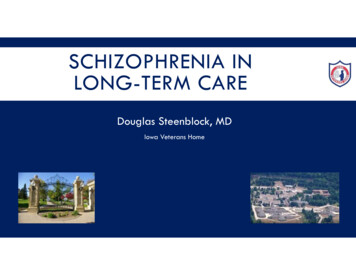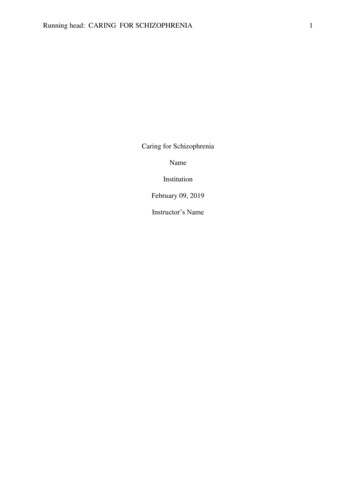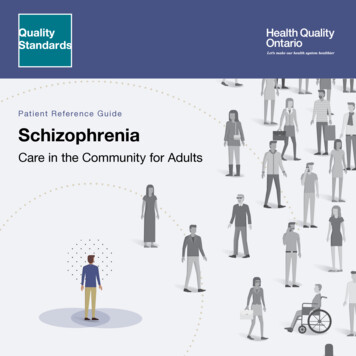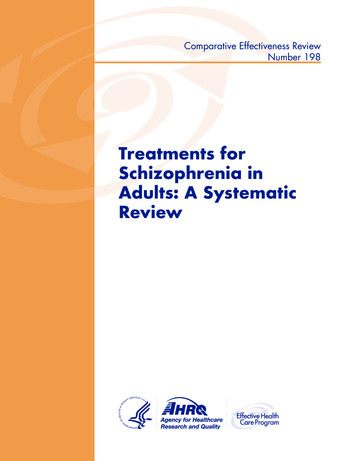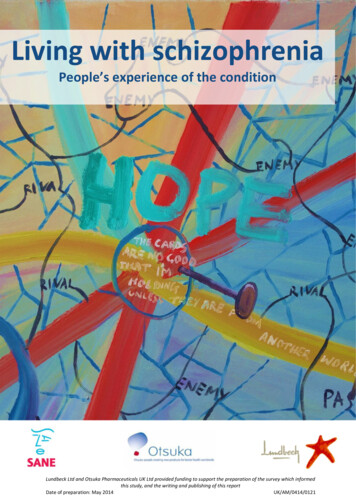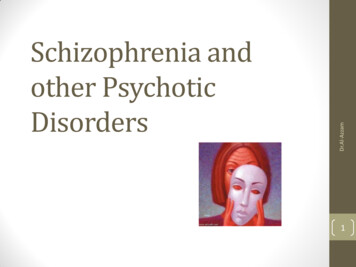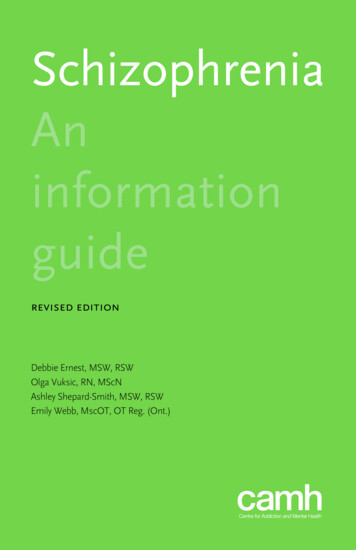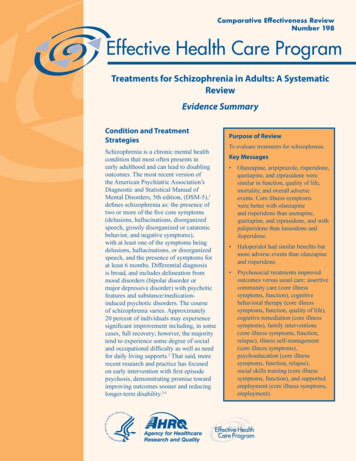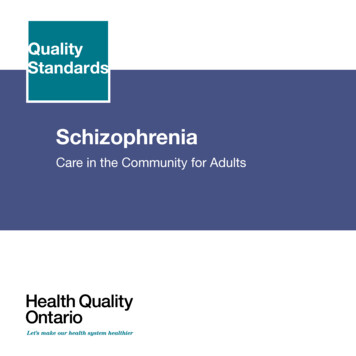
Transcription
SchizophreniaCare in the Community for Adults
SummaryThis quality standard addresses care for adults aged18 years and older with a diagnosis of schizophrenia,including related disorders such as schizoaffective disorder.The quality standard focuses on care provided in thecommunity, including primary care, hospital outpatient care,rehabilitation, care in correctional facilities, and communitysupports and services. It also provides guidance on earlypsychosis intervention for people experiencing a first episodeof schizophrenia.For a quality standard that addresses care for adults withschizophrenia who present at the emergency department orare admitted to hospital, please refer to the quality standardSchizophrenia: Care for Adults in Hospitals.
Table of ContentsAbout Quality Standards1How to Use Quality Standards1About This Quality Standard2Scope of This Quality Standard2Terminology Used in This Quality Standard2Why This Quality Standard Is Needed4Principles Underpinning This Quality Standard5How Success Can Be Measured7Quality Statements in Brief9Quality Statement 1: Care Plan and Comprehensive Assessment11Quality Statement 2: Physical Health Assessment16Quality Statement 3: Self-Management20Quality Statement 4: Family Education, Support, and Intervention23Quality Statement 5: Access to Community-Based Intensive Treatment Services26Quality Statement 6: Housing31Quality Statement 7: Antipsychotic Monotherapy34Quality Statement 8: Treatment With Long-Acting InjectableAntipsychotic Medication39Quality Statement 9: Treatment With Clozapine42Quality Statement 10: Continuation of Antipsychotic Medication45
TA B L E O F C O N T E N T S C O N T I N U E DQuality Statement 11: Cognitive Behavioural Therapy for Psychosis andOther Psychosocial Interventions49Quality Statement 12: Promoting Physical Activity and Healthy Eating54Quality Statement 13: Promoting Smoking Cessation57Quality Statement 14: Assessing and Treating Substance Use Disorder60Quality Statement 15: Employment and Occupational Support64Emerging Practice Statement: Peer Support, Illness Managementand Recovery Training, Wellness Recovery Action Planning,and Social Skills Training68Acknowledgements69References71About Health Quality Ontario76
About Quality StandardsHealth Quality Ontario, in collaboration with clinical experts, patients, residents, and caregiversacross the province, is developing quality standards for Ontario.Quality standards are concise sets of statements that will: Help patients, residents, families, and caregivers know what to ask for in their care Help health care professionals know what care they should be offering, based onevidence and expert consensus Help health care organizations measure, assess, and improve their performance incaring for patientsThe statements in this quality standard do not override the responsibility of health care professionalsto make decisions with patients, after considering each patient’s unique circumstances.How to Use Quality StandardsQuality standards inform clinicians and organizations about what high-quality health care lookslike for aspects of care that have been deemed a priority for quality improvement in the province.They are based on the best available evidence.They also include indicators to help clinicians and organizations assess the quality of care theyare delivering, and to identify gaps and areas for improvement. These indicators measure processes,structures, and outcomes.In addition, tools and resources to support clinicians and organizations in their quality improvementefforts accompany each quality standard.For more information on how to use quality standards, contact qualitystandards@hqontario.ca.Schizophrenia Care in the Community for Adults 1
About This Quality StandardScope of This Quality StandardThis quality standard addresses care for adults aged18 years and older with a primary diagnosisof schizophrenia, including related disorders such asschizoaffective disorder. It also provides guidance onearly psychosis intervention for people who experiencea first episode of schizophrenia. The quality standardfocuses on care provided in the community, includingprimary care, hospital outpatient care, rehabilitation, andcommunity supports and services.correctional system. For these individuals, it isparticularly important that screening processesat intake be sufficiently well developed that affectedindividuals can be diagnosed with schizophrenia.The quality standard also applies to care in correctionalfacilities. People with schizophrenia and other mentalhealth conditions are disproportionally representedin the correctional system.1 For some people withschizophrenia, their first point of contact for mentalhealth care is after becoming involved with theThis quality standard includes 15 quality statementsaddressing areas identified by Health QualityOntario’s Schizophrenia Care in the CommunityQuality Standard Advisory Committee as having highpotential to improve the quality of community-basedcare for adults with schizophrenia.For a quality standard that addresses care for adults withschizophrenia who present at the emergency departmentor are admitted to hospital, please refer to the qualitystandard Schizophrenia: Care for Adults in Hospitals.Terminology Used in This Quality StandardHealth Care Professionals, Providers, and TeamIn this quality standard, “health care professionals”refers to regulated professionals, such asphysicians, nurses, nurse practitioners, pharmacists,physiotherapists, psychologists, occupational therapists,social workers, and speech-language pathologists.2 Schizophrenia Care in the Community for AdultsThe term “health care providers” also includespeople in unregulated professions, such as recreationalstaff, peer support workers, administrative staff, andspiritual care staff. The term “health care team” isused when referring to all individuals who are involvedin providing care (including health care professionalsand health care providers).
A B O U T T H I S Q UA L I T Y S TA N D A R D C O N T I N U E DSubstitute Decision-Maker“Substitute decision-maker” refers to a person whomakes care and treatment decisions on anotherperson’s behalf if that person becomes mentallyincapable of making decisions for themself. Capacityis issue- or task-specific.2 The substitute decisionmaker should be involved in ongoing discussions withthe person about their goals of care, wishes, values,and beliefs so that the substitute decision-maker isempowered to participate in the health care consentprocess, if required. The substitute decision-makermakes decisions based on their understanding of theperson’s wishes or, if these wishes are unknown ornot applicable, makes choices that are consistent withthe person’s known values and beliefs and that are intheir best interests.Ontario’s Health Care Consent Act outlines ahierarchical list of people who are automaticallyconsidered a substitute decision-maker when a personis incapable of making decisions about their own care.3If a capable person prefers to assign someone to thisrole other than their automatic substitute decisionmaker, they can formally appoint someone else usinga “Power of Attorney for Personal Care.”4 This is a legaldocument in which one person gives another personthe authority to make personal care decisions on theirbehalf if they become mentally incapable.2Capacity or Mental CapacityUnder Ontario’s Health Care Consent Act, a person iscapable with respect to a health care decision if theyunderstand the information that is needed to makea decision and appreciate the consequences of thedecision or lack of decision.3 Capacity is issueor task-specific.2 A person’s specific capacity tounderstand information and appreciate the decisionsthat must be made should be respected so that theirabilities are recognized.5 A person may be capablewith respect to making some health care decisionsbut incapable with respect to others.3 A person mayalso be capable of making a health care decision atone time but incapable at another time.3 If a personis incapable with respect to making a health caredecision about a treatment or plan of treatment, thesubstitute-decision maker can give or refuse consenton the person’s behalf.3Schizophrenia Care in the Community for Adults 3
A B O U T T H I S Q UA L I T Y S TA N D A R D C O N T I N U E DCommunity Treatment Order“Community treatment order” refers to a legal order,issued by a physician, to provide a comprehensive planfor community-based treatment or care to a personwith a serious mental illness who has had difficultiesmaintaining their mental health in the community.6Informed by a community treatment plan, the orderoutlines the medications, medical appointments,and other aspects of care the physician believesare necessary to allow the person to stay well in thecommunity, rather than remain in hospital.7The plan may include, but is not limited to, thetreatments outlined in this quality standard.A community treatment order is developed by thephysician in collaboration with the person receivingtreatment or their substitute-decision maker, ifapplicable, and any other people or organizationsthat will assist the person in the community.7A community treatment order is valid only if theperson, or their substitute decision maker, providesconsent.7 Ontario’s Mental Health Act defines thecriteria necessary to issue and renew a communitytreatment order.6Why This Quality Standard Is NeededSchizophrenia is a severe, chronic mental healthcondition that usually begins in late adolescence orearly adulthood. The symptoms of schizophrenia canbe categorized as positive, negative, or cognitive.Positive symptoms include hallucinations, delusions,and disorganized speech and behaviour.8 Negativesymptoms include apathy, social withdrawal, emotionalflatness, and a restriction in the amount and contentof speech.8 Cognitive features include problems withmemory, attention, planning, and organizing.9In Canada, about 1 in 100 people have schizophrenia.10A 2012 report identified schizophrenia as one of the fivemental health and addictions–related conditions with4 Schizophrenia Care in the Community for Adultsthe greatest impact on the life and health of peoplein Ontario.11 The risk of developing schizophreniais influenced by a combination of genetic, physical,psychological, and environmental factors.12 The riskis higher in men, in people living in cities, and in familiesof recent immigrants.11,13People with schizophrenia die about 15 to 20 yearsearlier than the general population, with the majority ofthese premature deaths resulting from cardiovascular orchronic respiratory disease.14 People with schizophreniaare also much more likely to die by suicide comparedwith people without schizophrenia. In addition, peoplewith schizophrenia have an increased risk of having
A B O U T T H I S Q UA L I T Y S TA N D A R D C O N T I N U E Dother psychiatric conditions, including substanceuse disorders, depression, and anxiety. They arealso more likely to experience trauma, homelessness,and unemployment.12,15People with schizophrenia face important gaps inthe quality of care they receive in Ontario. Only 25%of people who are hospitalized for schizophreniaor psychosis receive a follow-up visit with aphysician within 7 days, and people hospitalized forschizophrenia have a high rate (12.5%) of readmissionwithin 30 days of discharge.16 Rates of emergencydepartment visits for schizophrenia vary widely acrossthe province.17 Access to psychiatrists also variesacross Ontario: in 2009, the number of psychiatristsper 100,000 people ranged from 7.2 to 62.7 per100,000 individuals across Ontario’s 14 local healthintegration networks.18People with schizophrenia are disproportionatelyaffected by homelessness, and are often precariouslyhoused.19 About 520,700 people living with mentalillness are inadequately housed in Canada and, ofthose, as many as 119,800 are homeless.19 Peoplewith schizophrenia are overrepresented in thesepopulations: it is estimated that 6% of the homelesspopulation in Toronto has schizophrenia.20The 15 quality statements that make up thisstandard provide guidance on high-quality careand offer accompanying indicators to help health careprofessionals and organizations measure the qualityof the care they provide. Each statement includesdetails about its effect on people with schizophrenia,their families and caregivers, health care professionals,community service providers, health care services, andcommunity support services at large.Principles Underpinning This Quality StandardThis quality standard is underpinned by the principlesof respect, equity, and recovery. As described bythe Mental Health Commission of Canada, “recoveryrefers to living a satisfying, hopeful, and contributinglife, even when a person may be experiencing ongoingsymptoms of a mental health problem or illness.”21The commission elaborates that “recovery journeysbuild on individual, family, cultural, and communitystrengths and can be supported by many types ofservices, supports, and treatments.”22People with schizophrenia have the right to receiveservices in an environment that promotes hope,empowerment, and optimism, and that embedsthe values and practices of recovery-oriented care.Many intersecting factors—including biological,psychological, social, economic, cultural, andspiritual considerations—may affect a person’smental health and well-being.22Schizophrenia Care in the Community for Adults 5
A B O U T T H I S Q UA L I T Y S TA N D A R D C O N T I N U E DPeople with schizophrenia and their families,caregivers, and personal supports should alsoreceive services that are respectful of their rightsand dignity, and that promote shared decision-makingand self-management.22 Further, people should beempowered to make informed choices about theservices that best meet their needs.21 People withschizophrenia should engage with their care providersin informed, shared deci
is incapable with respect to making a health care decision about a treatment or plan of treatment, the substitute-decision maker can give or refuse consent on the person’s behalf.3 ABOUT THIS QUALITY STANDARD CONTINUED . 4 Schizophrenia Care in the Community for Adults ABOUT THIS QUALITY STANDARD CONTINUED Community Treatment Order “Community treatment order” refers



